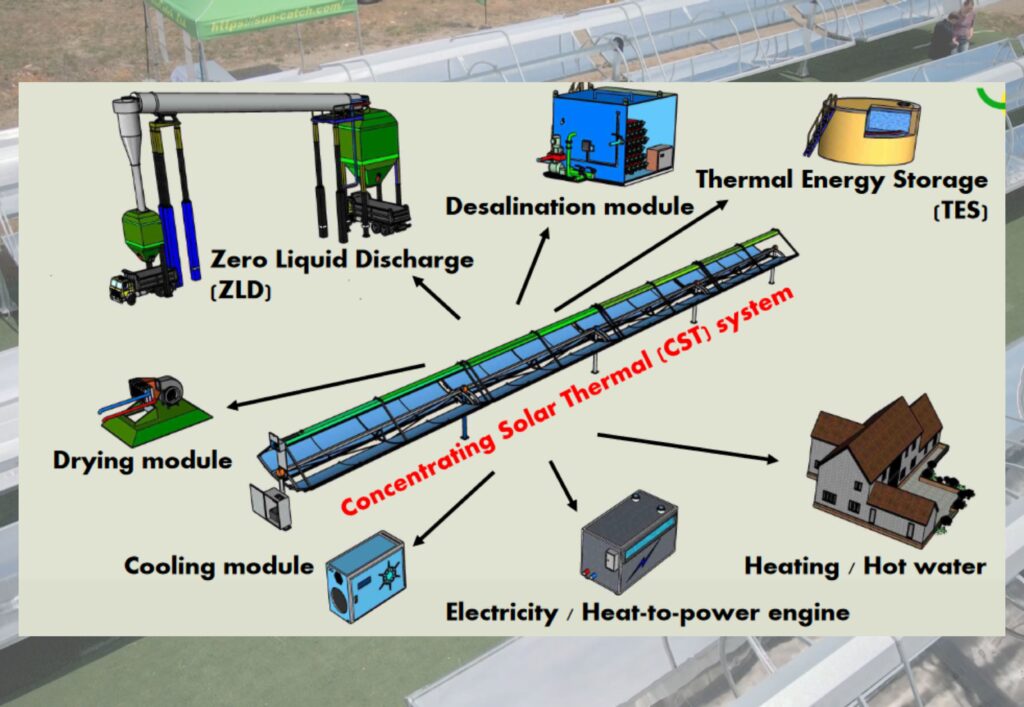
Exploring Solar Thermal Desalination and its Benefits: Harnessing the Power of the Sun
A promising solution is emerging that harnesses the power of the sun – solar thermal desalination. As the global population continues to grow, the demand for clean, accessible water has become an increasingly pressing concern.
Traditional methods of water purification, such as reverse osmosis and thermal distillation, often rely on energy-intensive processes that contribute to our carbon footprint.
By leveraging the abundant and renewable power of the sun, this innovative technology is transforming the future of water sustainability worldwide.
In this article, we will delve into the intricacies of solar-powered desalination, exploring how it works, its advantages, and the challenges it faces. We’ll also examine the various types of solar thermal desalination technology, share inspiring case studies, and discuss the environmental and economic benefits of this innovative approach to water purification.
Table of Contents
The Principles of Solar Thermal Desalination
Solar thermal desalination harnesses the natural process of evaporation and condensation to purify water. The system typically consists of a solar collector, which absorbs the sun’s energy to heat saline or brackish water, and a condensation chamber, where the water vapor is cooled and collected as freshwater.
This process effectively separates the salt and other impurities from the water, leaving behind a clean, potable supply.
Solar Collectors: Harnessing the Sun’s Energy
The heart of a solar thermal desalination system is the solar collector, which can take various forms, including flat-plate collectors, parabolic trough collectors, and solar towers.
These collectors harness the sun’s thermal energy, converting it into heat that is then used to warm the water. The design and efficiency of the solar collector play a crucial role in the overall performance of the desalination system.
Evaporation and Condensation: The Purification Process
As the saline or brackish water is heated in the solar collector, it begins to evaporate. The water vapor then travels to the condensation chamber, where it encounters a cooler surface. This temperature difference causes the water vapor to condense, forming pure water droplets that can be collected and stored for use.
Membrane Distillation: An Innovative Approach
Solar thermal desalination can also be coupled with membrane distillation, a process that utilizes a hydrophobic membrane to separate the heated, saline water from the cooler, purified water.
The water vapor passes through the membrane, leaving behind the salt and other impurities, resulting in a highly efficient and sustainable desalination solution.
Comparison to Conventional Desalination
The most common desalination method today is reverse osmosis, which uses high pressure to force water through a membrane that filters out salt. While effective, reverse osmosis requires a significant amount of energy, typically from fossil fuels.
Solar thermal desalination, on the other hand, uses the sun’s natural energy, making it far more sustainable. Additionally, it has fewer mechanical parts, reducing maintenance costs and operational complexities.

Advantages of Solar Thermal Desalination
The adoption of solar-powered desalination technology brings with it a host of benefits, both for the environment and for communities in need of clean water. Let’s explore some of the key advantages:
- Renewable Energy Source: By harnessing the power of the sun, solar thermal desalination systems reduce our reliance on fossil fuels and contribute to a more sustainable future.
- Reduced Carbon Footprint: Traditional desalination methods often have a significant carbon footprint due to their energy-intensive nature. Solar-powered desalination, on the other hand, drastically reduces greenhouse gas emissions, making it a more eco-friendly option.
- Off-Grid Capabilities: Solar thermal desalination systems can be deployed in remote or isolated areas, providing access to clean water for communities that may not have reliable electricity or infrastructure.
- Cost-Effectiveness: While the initial investment in solar-powered desalination technology may be higher, the long-term operating costs are often lower than those of traditional desalination methods, thanks to the free and abundant supply of solar energy.
- Scalability: Solar-powered desalination systems can be designed to meet the specific water needs of a community, making them highly adaptable and scalable to accommodate changing demands.
- Water Security: By diversifying the sources of water and reducing reliance on traditional water supplies, solar thermal desalination can enhance water security and resilience, especially in regions facing water scarcity.
Challenges and Considerations of Solar Thermal Desalination
While solar-powered desalination offers numerous advantages, it also faces some challenges and limitations that need to be addressed:
- Initial Investment: The upfront cost of installing solar thermal desalination systems can be higher than traditional desalination methods, which can be a barrier to widespread adoption, especially in developing regions.
- Intermittent Energy Supply: The sun’s energy is intermittent, and solar thermal desalination systems may face challenges during periods of low sunlight or cloudy conditions, requiring backup energy sources or storage solutions.
- Water Quality: Ensuring consistent water quality and meeting the necessary standards for potable water can be a challenge, as the desalination process may not always remove all contaminants or impurities.
- Maintenance and Operational Complexity: Solar thermal desalination systems require regular maintenance and monitoring to ensure optimal performance, which can be a challenge in remote or resource-constrained areas.
- Geographical Limitations: The effectiveness of solar thermal desalination is heavily dependent on the availability of sufficient sunlight and suitable land or water resources, which may limit its applicability in certain regions.
Despite these challenges, researchers and innovators are continuously working to address these limitations and make solar-powered desalination a more viable and accessible solution for communities in need.
Related topics: SunCatch Develops Scalable Concentrated Solar-Thermal Technology Achieving 92% Efficiency
Different Types of Solar Thermal Desalination Technology
Solar thermal desalination encompasses a range of technologies, each with its own unique features and applications. Here are some of the most prominent types of solar thermal desalination systems:
- Multi-Effect Distillation (MED):
- This technology uses multiple stages of evaporation and condensation to purify water.
- MED systems are known for their high efficiency and can produce high-quality water.
- Multi-Stage Flash (MSF) Distillation:
- MSF systems use a series of chambers with decreasing pressure to evaporate and condense water.
- This method is suitable for large-scale desalination projects and can handle high salinity levels.
- Solar Humidification-Dehumidification (HDH):
- HDH systems mimic the natural water cycle, using the sun’s heat to evaporate water and then condense it.
- This technology is relatively simple and can be deployed in small-scale applications.
- Solar Pond Desalination:
- This method uses a saltwater pond with a gradient of salt concentration to trap the sun’s heat and drive the evaporation process.
- Solar pond desalination is a low-cost option, but it requires a large surface area and can be affected by environmental factors.
- Solar Membrane Distillation (MD):
- MD systems use a semi-permeable membrane to separate water vapor from the saline solution, driven by the temperature difference.
- This technology is known for its high energy efficiency and ability to handle high-salinity water.
Each of these solar thermal desalination technologies has its own strengths and weaknesses, and the choice of the most suitable system depends on factors such as water salinity, scale, and local environmental conditions.
Desalination as a Solution
Water scarcity is one of the biggest challenges facing humanity today. The United Nations estimates that by 2025, two-thirds of the world’s population may experience water stress—where the demand for freshwater exceeds the available supply.
Climate change is further exacerbating the problem by altering rainfall patterns, reducing river flows, and causing glaciers (which many communities rely on for water) to melt.
Rising Demand for Freshwater
It’s not just population growth driving the demand for freshwater—industrialization, agriculture, and urbanization all play a role. Agriculture alone accounts for approximately 70% of global freshwater use, particularly in water-intensive practices such as rice and cotton farming. As more countries develop industrially, the need for freshwater for factories, energy production, and cooling systems skyrockets.
Solar Thermal Desalination: Helpful & Eco-friendly
Given that nearly 97% of the Earth’s water is salty, desalination—the process of removing salt and other minerals from seawater—has emerged as a solution.
Conventional desalination methods, such as reverse osmosis, are widely used but are extremely energy-intensive and costly. They often rely on fossil fuels, which contribute to carbon emissions and environmental degradation. Enter solar thermal desalination, a greener, more sustainable option.
Related topics: How SunCatch Solar Tech Helps Farming Industries Save Money while Saving the Environment
Case Studies and Success Stories of Solar-Powered Desalination Projects
To better understand the real-world applications and successes of solar-powered desalination, let’s explore a few compelling case studies:
- Baja California, Mexico:
- In this remote region, a solar-powered reverse osmosis desalination plant was installed to provide clean water to a small coastal community.
- The project has been successful in delivering reliable, sustainable water to the residents, reducing their reliance on expensive and environmentally harmful water trucking.
- Socotra Island, Yemen:
- This isolated island in the Indian Ocean faced severe water scarcity, with limited access to freshwater resources.
- A solar-powered desalination system was implemented, providing clean water to the local population and supporting agricultural development.
- The project has significantly improved the quality of life and economic opportunities for the island’s residents.
- Masdar City, United Arab Emirates:
- As part of its commitment to sustainability, the Masdar City development in Abu Dhabi has incorporated a solar-powered desalination plant.
- The plant uses concentrated solar power to drive a multi-effect distillation process, producing high-quality water for the city’s residents and businesses.
- This project showcases the potential for solar-powered desalination in urban settings and its role in creating sustainable communities.
These case studies demonstrate the real-world impact of solar-powered desalination, highlighting its ability to address water scarcity, improve access to clean water, and foster sustainable development in diverse geographical and socioeconomic contexts.
The Future of Solar-Powered Desalination
As the world grapples with the challenges of water scarcity and the need for sustainable water solutions, the future of solar-powered desalination looks increasingly promising. With ongoing research, technological advancements, and growing global awareness, we can expect to see significant progress in this field in the years to come.
Some key trends and developments that are shaping the future of solar-powered desalination include:
- Improved Efficiency and Cost Reduction: Researchers and engineers are working to enhance the efficiency of solar-powered desalination systems, while also finding ways to reduce the upfront and operational costs, making the technology more accessible and economically viable.
- Hybrid and Integrated Systems: The integration of solar-powered desalination with other renewable energy sources, such as wind or geothermal, as well as the development of hybrid systems that combine different desalination technologies, can improve the overall reliability and performance of these systems.
- Advances in Membrane and Material Science: Ongoing advancements in membrane technology and the development of new materials for solar thermal collectors and other system components can lead to improved water quality, increased energy efficiency, and reduced maintenance requirements.
- Scalability and Modularity: The ability to design and deploy solar-powered desalination systems that can be easily scaled to meet the specific needs of communities or regions will be crucial for widespread adoption and impact.
- Increased Awareness and Policy Support: As the world recognizes the importance of sustainable water solutions, we can expect to see greater policy support, funding, and public awareness, which will further drive the development and deployment of solar-powered desalination technologies.
By harnessing the power of the sun and leveraging the latest technological innovations, the future of solar-powered desalination holds immense promise for addressing the global water crisis and creating a more sustainable and equitable future.
Latest Posts
- Reverse Osmosis vs Thermal Desalination: Which is Better for Water Desalination?Reverse Osmosis vs Thermal Desalination: Which is Better for Water Desalination? When it comes to the leading technologies in the field of desalination, comparing reverse osmosis vs thermal desalination highlights two distinct approaches to obtaining fresh water from seawater, each with its own strengths and application. Water scarcity is a global challenge that continues to… Read more: Reverse Osmosis vs Thermal Desalination: Which is Better for Water Desalination?
- Understanding Thermal Desalination: Process, Benefits, and Solar-Powered InnovationsUnderstanding Thermal Desalination: Process, Benefits, and Solar-Powered Innovations Through the remarkable process of thermal desalination, we can be one step closer to a future where communities, farms, and industries alike can enjoy a steady flow of clean, fresh water. With about 70% of the Earth’s surface covered by water, it might seem like there’s an… Read more: Understanding Thermal Desalination: Process, Benefits, and Solar-Powered Innovations
- DISCOVER THE FUTURE OF SOLAR THERMAL SYSTEMS FOR YOUR HOME AND BUSINESSWhat are solar thermal systems? In today’s world of rising energy costs and growing environmental concerns, the search for sustainable energy solutions has never been more urgent. Solar thermal systems offer a promising avenue to reduce our reliance on fossil fuels and embrace a cleaner, greener future. Imagine a world where your home or business… Read more: DISCOVER THE FUTURE OF SOLAR THERMAL SYSTEMS FOR YOUR HOME AND BUSINESS
- NET ZERO SOLAR THERMAL SOLUTIONS: What you need to eliminate your farming hot water bill!What is Net Zero Solar Thermal Solutions Are you looking for ways to eliminate your farming hot water bill or significantly reduce your energy consumption? Let me introduce you to a Net Zero Solar Thermal Solution that is revolutionizing the way we harness energy for farms and beyond. We are thrilled to introduce our groundbreaking… Read more: NET ZERO SOLAR THERMAL SOLUTIONS: What you need to eliminate your farming hot water bill!



